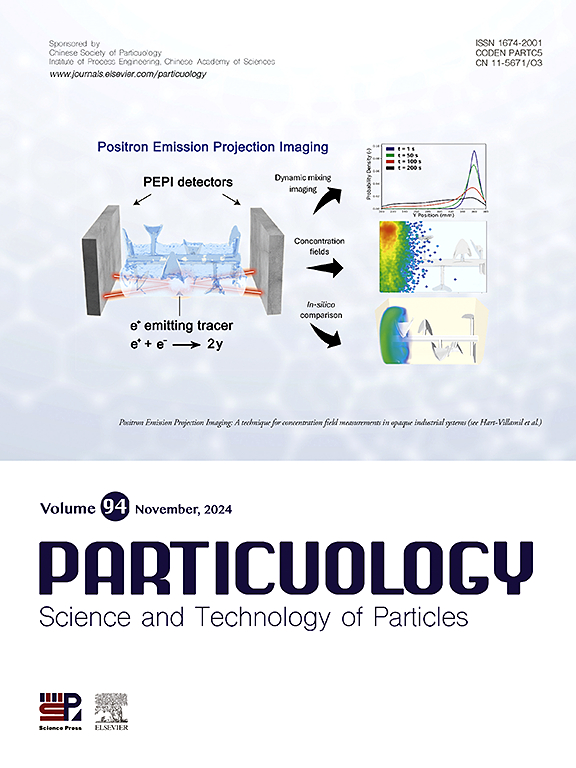Particle motion and enrichment behavior of dense granular impinging-jets generated by the nozzle with rectangular orifice
IF 4.1
2区 材料科学
Q2 ENGINEERING, CHEMICAL
引用次数: 0
Abstract
Particle motion regime and enrichment behavior of dense granular impinging-jets formed by the nozzle with rectangular orifice are experimentally and numerically investigated. Two impingement patterns are identified, including long and short parallel patterns. Particles enrich in the central axis of the granular sheet when two jets impinge with the long axes parallel pattern. While at the short axes parallel pattern, particles generate two symmetrical enriched streams. The angle of particle-enriched streams is observed to increase with increasing angle of two impinging-jets and decreasing aspect ratio of the nozzle orifice. The particle image velocity (PIV) analysis results demonstrate that the circumferential distribution of the particle velocity on the granular sheet follows the Gaussian distribution. With the formation of particle-enriched streams, the concentration distribution of the particle evolves into a trimodal pattern. Results of the discrete element method (DEM) indicate that the core region with low velocity within the impact zone of impinging-jets generated by using two nozzles with rectangular orifices extends into a shuttle shape. The core region develops and extends along the horizontal (or vertical) directions at long (or short) axes impingement pattern, thereby, affecting the enrichment behavior of particles.

矩形孔喷嘴密集颗粒射流的颗粒运动与富集行为
实验和数值研究了矩形孔喷管形成的致密颗粒射流的颗粒运动规律和富集行为。确定了两种撞击模式,包括长平行模式和短平行模式。当两个射流以长轴平行模式撞击时,颗粒在颗粒片的中轴线富集。而在短轴平行模式下,粒子产生两个对称的富集流。富颗粒流的夹角随着两射流夹角的增大和喷嘴长径比的减小而增大。粒子图像速度(PIV)分析结果表明,粒子速度在颗粒片上的周向分布服从高斯分布。随着富颗粒流的形成,颗粒的浓度分布演变为三模态分布。离散元法(DEM)计算结果表明,矩形孔喷管产生的射流冲击区内低速核心区呈梭形扩展。核心区沿水平(或垂直)方向以长轴(或短轴)撞击模式发育和延伸,从而影响颗粒的富集行为。
本文章由计算机程序翻译,如有差异,请以英文原文为准。
求助全文
约1分钟内获得全文
求助全文
来源期刊

Particuology
工程技术-材料科学:综合
CiteScore
6.70
自引率
2.90%
发文量
1730
审稿时长
32 days
期刊介绍:
The word ‘particuology’ was coined to parallel the discipline for the science and technology of particles.
Particuology is an interdisciplinary journal that publishes frontier research articles and critical reviews on the discovery, formulation and engineering of particulate materials, processes and systems. It especially welcomes contributions utilising advanced theoretical, modelling and measurement methods to enable the discovery and creation of new particulate materials, and the manufacturing of functional particulate-based products, such as sensors.
Papers are handled by Thematic Editors who oversee contributions from specific subject fields. These fields are classified into: Particle Synthesis and Modification; Particle Characterization and Measurement; Granular Systems and Bulk Solids Technology; Fluidization and Particle-Fluid Systems; Aerosols; and Applications of Particle Technology.
Key topics concerning the creation and processing of particulates include:
-Modelling and simulation of particle formation, collective behaviour of particles and systems for particle production over a broad spectrum of length scales
-Mining of experimental data for particle synthesis and surface properties to facilitate the creation of new materials and processes
-Particle design and preparation including controlled response and sensing functionalities in formation, delivery systems and biological systems, etc.
-Experimental and computational methods for visualization and analysis of particulate system.
These topics are broadly relevant to the production of materials, pharmaceuticals and food, and to the conversion of energy resources to fuels and protection of the environment.
 求助内容:
求助内容: 应助结果提醒方式:
应助结果提醒方式:


